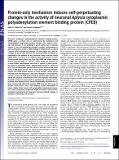| dc.contributor.author | Heinrich, Sven U. | |
| dc.contributor.author | Lindquist, Susan | |
| dc.date.accessioned | 2011-07-29T18:52:49Z | |
| dc.date.available | 2011-07-29T18:52:49Z | |
| dc.date.issued | 2011-02 | |
| dc.date.submitted | 2010-11 | |
| dc.identifier.issn | 1091-6490 | |
| dc.identifier.uri | http://hdl.handle.net/1721.1/64990 | |
| dc.description.abstract | Neuronal cytoplasmic polyadenylation element binding protein (CPEB) plays a critical role in maintaining the functional and morphological long-lasting synaptic changes that underlie learning and memory. It can undergo a prion switch, but it remains unclear if this self-templating change in protein conformation is alone sufficient to create a stable change in CPEB activity: a robust “protein-only” biochemical memory. To investigate, we take advantage of yeast cells wherein the neuronal CPEB of Aplysia is expressed in the absence of any neuronal factors and can stably adopt either an active or an inactive state. Reminiscent of well-characterized yeast prions, we find that CPEB can adopt several distinct activity states or “strains.” These states are acquired at a much higher spontaneous rate than is typical of yeast prions, but they are extremely stable—perpetuating for years—and have all of the non-Mendelian genetic characteristics of bona fide yeast prions. CPEB levels are too low to allow direct physical characterization, but CPEB strains convert a fusion protein, which shares only the prion-like domain of CPEB, into amyloid in a strain-specific manner. Lysates of CPEB strains seed the purified prion domain to adopt the amyloid conformation with strain-specific efficiencies. Amyloid conformers generated by spontaneous assembly of the purified prion domain (and a more biochemically tractable derivative) transformed cells with inactive CPEB into the full range of distinct CPEB strains. Thus, CPEB employs a prion mechanism to create stable, finely tuned self-perpetuating biochemical memories. These biochemical memories might be used in the local homeostatic maintenance of long-term learning-related changes in synaptic morphology and function. | en_US |
| dc.description.sponsorship | Ruth L. Kirschstein National Research Service Award (Fellowship AGO30269) | en_US |
| dc.language.iso | en_US | |
| dc.publisher | National Academy of Sciences (U.S.) | en_US |
| dc.relation.isversionof | http://dx.doi.org/10.1073/pnas.1019368108 | en_US |
| dc.rights | Article is made available in accordance with the publisher's policy and may be subject to US copyright law. Please refer to the publisher's site for terms of use. | en_US |
| dc.source | PNAS | en_US |
| dc.title | Protein-only mechanism induces self-perpetuating changes in the activity of neuronal Aplysia cytoplasmic polyadenylation element binding protein (CPEB) | en_US |
| dc.type | Article | en_US |
| dc.identifier.citation | Heinrich, S. U., and S. Lindquist. “Protein-only Mechanism Induces Self-perpetuating Changes in the Activity of Neuronal Aplysia Cytoplasmic Polyadenylation Element Binding Protein (CPEB).” Proceedings of the National Academy of Sciences 108.7 (2011) : 2999-3004. ©2011 by the National Academy of Sciences. | en_US |
| dc.contributor.department | Massachusetts Institute of Technology. Department of Biology | en_US |
| dc.contributor.department | Whitehead Institute for Biomedical Research | en_US |
| dc.contributor.approver | Lindquist, Susan | |
| dc.contributor.mitauthor | Lindquist, Susan | |
| dc.relation.journal | Proceedings of the National Academy of Sciences of the United States of America | en_US |
| dc.eprint.version | Final published version | en_US |
| dc.type.uri | http://purl.org/eprint/type/JournalArticle | en_US |
| eprint.status | http://purl.org/eprint/status/PeerReviewed | en_US |
| dspace.orderedauthors | Heinrich, S. U.; Lindquist, S. | en |
| dc.identifier.orcid | https://orcid.org/0000-0003-1307-882X | |
| mit.license | PUBLISHER_POLICY | en_US |
| mit.metadata.status | Complete | |
